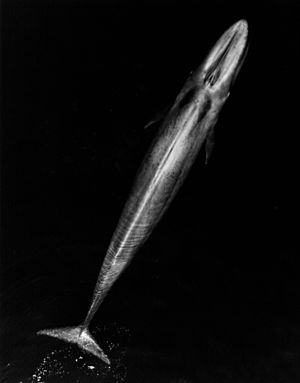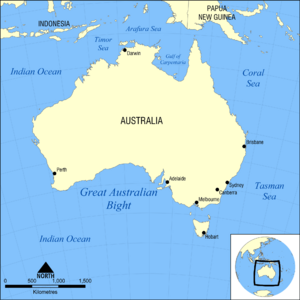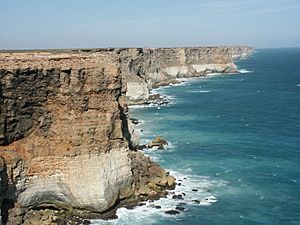Great South Australian Coastal Upwelling System facts for kids
The Great Southern Australian Coastal Upwelling System is a special ocean area. It's found in the eastern part of the Great Australian Bight. This area stretches about 800 kilometers (500 miles) from Ceduna, South Australia, to Portland, Victoria.
During the Australian summer (November to May), strong winds blow from the southeast. These winds push the surface water away from the coast. When this happens, cold water from deep in the ocean rises to the surface. This process is called an upwelling.
The deep ocean water is full of important nutrients. These nutrients act like food for tiny ocean plants. Because of this, the upwelling area is very different from other parts of the Great Australian Bight, which don't have as many nutrients. Every summer, this upwelling helps a rich ocean ecosystem to grow. It even attracts huge blue whales and supports many fishing businesses.
This system is Australia's only deep-reaching coastal upwelling. This means the nutrient-rich water comes from very deep, sometimes more than 300 meters (980 feet) down! A new upwelling spot was recently found near Tasmania. Because of this, the system is now called the Great Southern Australian Coastal Upwelling System.
Contents
How Ocean Upwelling Works
During the Australian summer, high-pressure systems over the Great Australian Bight cause southeasterly winds. These winds blow along the coasts of Victoria and South Australia. In the southern hemisphere, when winds blow parallel to the shore, they push water to the left. This means the water moves away from the coast.
To replace the water that moves offshore, cold water from the ocean floor rises up. This is how upwelling happens. When upwelling events occur, the ocean surface temperature can drop by 2-3 degrees Celsius (3.6-5.4 degrees Fahrenheit).
There are three main places where upwelling happens. These are called upwelling centers. The Kangaroo Island and Eyre Peninsula centers work in a similar way. Upwelling events happen almost at the same time in all three centers. They appear within a few days of each other, even though they are about 800 kilometers (500 miles) apart.
The strongest and most reliable upwelling happens at a place called the Bonney Upwelling. Scientists have known about the Bonney Upwelling for over 30 years. However, they only discovered how big the entire upwelling system was in 2004.
The Bonney Upwelling
The Bonney Upwelling is the biggest and most predictable upwelling in the system. It stretches from Portland, Victoria to Robe, South Australia. In this area, the continental shelf is quite narrow. It's only about 20 kilometers (12 miles) from the shore to the deep ocean. This narrow shelf helps funnel deep water up to the surface through underwater canyons.
Kangaroo Island and Eyre Peninsula Upwelling
Upwelling near Kangaroo Island and the Eyre Peninsula is a bit different. Here, the continental shelf is much wider, sometimes up to 100 kilometers (62 miles) wide. Water doesn't come directly from the deep ocean floor to the surface.
Instead, a chain of events causes the upwelling. It starts in deep underwater canyons south of Kangaroo Island. Here, cold water from the very deep ocean (called abyssal plains) rises to the continental shelf. This cold, dense water forms a pool called the Kangaroo Island Pool. This pool then drifts along the bottom of the shelf near Kangaroo Island and the Eyre Peninsula.
When the right winds blow, cold water is pulled up from this pool. This happens two to three times each summer. So, the water doesn't come directly from the ocean floor, but from this special cold-water pool.
Ocean Life and Ecosystem


The upwelling brings many nutrients to the surface. This makes the Great Southern Australian Coastal Upwelling System a very important "hot spot" for marine life. During upwelling events, the amount of life here can be as rich as some of the world's most productive upwelling areas. These include places off the coasts of Peru, California, and Namibia.
When upwelling happens, the amount of tiny ocean plants (called phytoplankton) increases a lot. These phytoplankton blooms attract huge swarms of krill. Krill are small, shrimp-like creatures.
The abundance of krill then attracts blue whales. Blue whales are the largest animals on Earth! They are found in different places off Australia's southeast coast. But they are most common in the Bonney Upwelling region. This is one of only 12 known blue whale feeding sites in the world.
One marine biologist, Peter Gill, believes that about 100 blue whales visit the Bonney Upwelling area every year. They travel over 18,000 square kilometers (6,900 square miles) of ocean. This area stretches from Robe, South Australia to Cape Otway in Victoria. Their feeding grounds might even extend further, but more research is needed to know for sure.
Other marine animals also thrive in the upwelling. These include filter feeders like sponges, bryozoans, and corals. These animals are food for predators like seabirds, fish, Australian fur seals, and penguins.
The upwelling is also important for young southern bluefin tuna. These tuna gather in the eastern Great Australian Bight during the upwelling season. They feed on sardines and anchovies. Also, many dead organisms sink to the continental shelf. This provides food for animals like southern rock lobster and giant crab.
Economic Importance
The Great Southern Australian Coastal Upwelling System supports a very productive fishing industry. Local fishers know how much the upwelling helps them. Every November, Portland, Victoria, even hosts an Upwelling Festival. This festival celebrates the rich ocean life from the Bonney Upwelling and marks the start of the summer fishing season.
People have used the resources from this upwelling for thousands of years. Old stories from local Aboriginal tribes show they had a strong connection to the ocean. They may have eaten beached whales. In 1829, a conflict called the Convincing Ground massacre happened near Portland, Victoria. It was a disagreement between European whalers and the Gunditjmara people over who owned a beached whale. In the mid-1840s, whaling and sealing became organized industries off the Bonney Coast.
Today, southern rock lobster (often called crayfish) and trawling are the most important fishing industries in the Bonney Upwelling. The upwelling off the Eyre Peninsula supports a large sardine fishery. This fishery mainly operates out of Port Lincoln, South Australia.
Protecting the Upwelling System
The Great Southern Australian Coastal Upwelling System and its amazing ecosystem are like one of Australia's natural wonders. It's as important as the Great Barrier Reef.
Because it's such a vital feeding and gathering place for blue whales, the Bonney Upwelling was listed as "critical habitat" in 2002. This means it needs strong protection from human activities. This protection is under Australia's Environment Protection and Biodiversity Conservation Act 1999.
Besides the blue whale, one type of shark is listed as critically endangered here. Also, five bird species and two other whale species are listed as endangered.
There are also large amounts of natural gas under the Bonney Coast. Companies are exploring these gas reserves. Some people are worried that more gas drilling could harm whales. This could happen through noise pollution from drilling or collisions with ships.



